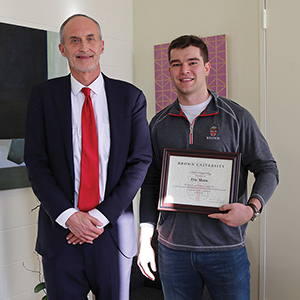When researchers were busy in the Breuer Lab with the idea of a bio-inspired wing on a small drone, an undergraduate in the lab was demonstrating a quick understanding of the science underlying the project. He was searching for the conditions that would make both the wing’s performance, and his own, arrive at a predictable outcome.

Eric Shaw ’20 was completing a four-year academic script which included mechanical engineering alongside East Asian studies. In high school, he had excelled at Mandarin, and wanted to continue his studies in college. “I loved the language and was fascinated with it. I knew I wanted to continue learning in college. I also knew I wanted to do some sort of aeronautical or aerospace engineering. So, if I was going to take all 21 engineering credits, and every semester I also wanted to take my Mandarin language courses, that would cut out more than half of the required East Asian studies classes. It was either take a lighter course load, or take six additional East Asian studies — history-type classes — outside of Mandarin. To me, it was well worth it for just a bit more of a push to get that double concentration.”
So push he did, and after taking Professor Kenny Breuer’s Introduction to Fluid Mechanics class his junior year, he joined the Breuer Lab. He spent that spring watching and learning, and getting to know the people associated with the lab.
“I definitely wanted to do research my senior year,” Shaw continued. “I think the independent capstone project is a great option that Brown gives to engineers. I’ve always been kind of an aviation nerd, so after taking Professor Breuer’s classes, it seemed natural to join the Breuer Lab.
“Professor Breuer and I talked the summer before my senior year to try and find a capstone project, and he knew (Ph.D. candidate) Matteo (DiLuca) needed some extra hands on his project, and what needed to be done. It seemed pretty interesting, so I jumped at the option. I used that as my capstone course credit.”
That capstone project was to study the aerodynamic behavior of a “separated flow airfoil” – a wing geometry in which the flow is deliberately forced to separate at the leading edge so that its aerodynamic performance in certain flow conditions is found to be predictable and well-controlled. Shaw designed the model using Solidworks and COMSOL, constructing the experimental setup and wind tunnel experiments.
He was awarded the Doris M. and Norman T. Halpin prize, seed funding which supports a senior’s innovative design project. “The wind tunnel time itself is quite expensive so without that prize money, I don’t know how I would have completed the research,” he said. “Because the funds were there, it was always open to me, and there was never any barrier to the wind tunnel use. Also, I don’t know how many iterations of the airfoil I had to go through, but the 3D resin printing for that is quite costly which would have been a strain on the lab. Being able to have everything I needed, almost as soon as I needed it, helped speed up the research. I don’t think my results would have been possible without having that economic freedom,” he said.
By winter, Shaw’s capstone was complete, and DiLuca and Breuer’s paper was published in Science Robotics in January (see page 16 of this magazine). Shaw would spend the spring semester working on his own thesis as a relative continuation of the project, adding more experimental data and attempting to address efficiency limitations that are notorious in low speed, small scale aerial drone flight. Coupling the capstone resiliency results with efficiency increases shows great promise in addressing many of the problems that plague small scale aerial drone flying.
“To be co-author of a published paper in a journal like Science Robotics is pretty invaluable as an undergrad. And without both Kenny and Matteo’s willingness to onboard me, none of that would have been possible. When I first visited Brown, the only thing I knew about the school was the open curriculum and that there seemed to be a major emphasis on its undergrads that a lot of other schools of similar caliber didn’t really emphasize. This certainly proved to be true.
“There are grad students and Ph.D. students in the lab who have been doing this for years, and then you show up as an undergrad just trying not to break the machines, and everyone is super open to it all,” he laughed. “I would just like to emphasize how welcome I felt by the lab, and all the opportunities it afforded me.”
Shaw, whose outcome resulted in an employment opportunity with Lockheed Martin, credits the capstone course and thesis for the next step in his journey: “There is no doubt that, in job interviews, being able to discuss my capstone publication and thesis experimentation caught a lot of people’s eyes.”